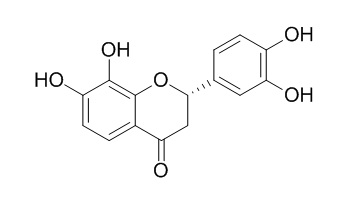Isookanin
Isookanin shows strong diphenyl(2,4,6-trinitrophenyl)iminoazanium (DPPH) radical-scavenging activity, with the IC50 value of 7.9 ± 0.53 uM. Isookanin is a potent inhibitor of α-amylase (IC₅₀=0.447 mg/ml).
Inquire / Order:
manager@chemfaces.com
Technical Inquiries:
service@chemfaces.com
Tel:
+86-27-84237783
Fax:
+86-27-84254680
Address:
1 Building, No. 83, CheCheng Rd., Wuhan Economic and Technological Development Zone, Wuhan, Hubei 430056, PRC
Providing storage is as stated on the product vial and the vial is kept tightly sealed, the product can be stored for up to
24 months(2-8C).
Wherever possible, you should prepare and use solutions on the same day. However, if you need to make up stock solutions in advance, we recommend that you store the solution as aliquots in tightly sealed vials at -20C. Generally, these will be useable for up to two weeks. Before use, and prior to opening the vial we recommend that you allow your product to equilibrate to room temperature for at least 1 hour.
Need more advice on solubility, usage and handling? Please email to: service@chemfaces.com
The packaging of the product may have turned upside down during transportation, resulting in the natural compounds adhering to the neck or cap of the vial. take the vial out of its packaging and gently shake to let the compounds fall to the bottom of the vial. for liquid products, centrifuge at 200-500 RPM to gather the liquid at the bottom of the vial. try to avoid loss or contamination during handling.
Front Plant Sci.2022, 13: 905275.
Biomed Pharmacother.2023, 166:115329.
Mol Nutr Food Res.2024, 68(20):e2400414.
Nutr Cancer.2022, 1-13.
Phytomedicine.2022, 99:153997.
J Ethnopharmacol.2020, 249:112396
J Ethnopharmacol.2019, 235:406-414
Phytomedicine2022, 104:154318
Korean J. Medicinal Crop Sci.2021, 29(1):45-50.
Nutrients.2022, 14(16):3393.
Related and Featured Products
7-O-Methyleriodictyol
Catalog No: CFN98833
CAS No: 51857-11-5
Price: Inquiry(manager@chemfaces.com)
Homoeriodictyol
Catalog No: CFN96489
CAS No: 446-71-9
Price: $388/20mg
Viscumneoside III
Catalog No: CFN89421
CAS No: 118985-27-6
Price: $288/10mg
Eriodictyol 7,3'-dimethyl ether
Catalog No: CFN89533
CAS No: 54352-60-2
Price: Inquiry(manager@chemfaces.com)
Hesperetin
Catalog No: CFN98842
CAS No: 520-33-2
Price: $40/20mg
Hesperetin-7-methyl ether
Catalog No: CFN90876
CAS No: N/A
Price: $198/10mg
7,3',4'-Tri-O-methyleriodictyol
Catalog No: CFN89491
CAS No: 70987-96-1
Price: Inquiry(manager@chemfaces.com)
(2S)-5,7,3',4'-tetramethoxyflavanone
Catalog No: CFN95406
CAS No: 74628-43-6
Price: $318/10mg
5,6,7,3',4'-Pentamethoxyflavanone
Catalog No: CFN95394
CAS No: 104193-93-3
Price: $318/5mg
Isookanin
Catalog No: CFN90850
CAS No: 1036-49-3
Price: $298/20mg
J Agric Food Chem. 2015 Jan 14;63(1):200-7.
New phenolic compounds from Coreopsis tinctoria Nutt. and their antioxidant and angiotensin i-converting enzyme inhibitory activities.[Pubmed:
25516207 ]
Three new phenolic compounds, coretinphenol (1), coretincone (2), and coretinphencone (3), were isolated from the buds of Coreopsis tinctoria Nutt., together with nine known compounds, including butein (4), okanin (5), isoliquiritigenin (6), maritimetin (7), taxifolin (8), Isookanin (9), marein (10), sachalinoside B (11), and 2-phenylethyl-β-d-glucoside (12).
METHODS AND RESULTS:
The chemical structures of these compounds were elucidated by extensive spectroscopic analysis and on the basis of their chemical reactivity. This work represents the first recorded example of the isolation of compounds 1–3, 6, 7, 9, 11, and 12 from C. tinctoria. Compounds 5–9 showed strong diphenyl(2,4,6-trinitrophenyl)iminoazanium (DPPH) radical-scavenging activity, with IC50 values of 3.35 ± 0.45, 9.6 ± 2.32, 4.12 ± 0.21, 6.2 ± 0.43, and 7.9 ± 0.53 μM, respectively. Compounds 2 and 8 exhibited angiotensin I-converting enzyme inhibitory activity, with IC50 values of 228 ± 4.47 and 145.67 ± 3.45 μM, respectively.
CONCLUSIONS:
The activities of phenolic compounds isolated from C. tinctoria support the medicinal use of this plant in the prevention of cardiovascular diseases.
Molecules . 2020 Jun 5;25(11):2631.
Subacute Oral Administration of Clinacanthus nutans Ethanolic Leaf Extract Induced Liver and Kidney Toxicities in ICR Mice[Pubmed:
32517000]
Abstract
This study investigated the leaves of Clinacanthus nutans for its bioactive compounds and acute and subacute toxicity effects of C. nutans ethanolic leaf extract (CELE) on blood, liver and kidneys of ICR mice. A total of 10 8-week-old female mice were divided into groups A (control) and B (2000 mg/kg) for the acute toxicity study. A single dose of 2000 mg/kg was administered to group B through oral gavage and mice were monitored for 14 days. In the subacute toxicity study, mice were divided into five groups: A (control), B (125 mg/kg), C (250 mg/kg), D (500 mg/kg) and E (1000 mg/kg). The extract was administered daily for 28 days via oral gavage. The mice were sacrificed, and samples were collected for analyses. Myricetin, orientin, isoorientin, vitexin, isovitexin, Isookanin, apigenin and ferulic acid were identified in the extract. Twenty-eight days of continuous oral administration revealed significant increases (p < 0.05) in creatinine, ALT and moderate hepatic and renal necrosis in groups D and E. The study concluded that the lethal dose (LD50) of CELE in mice is greater than 2000 mg/kg and that repeated oral administrations of CELE for 28 days induced hepatic and renal toxicities at 1000 mg/kg in female ICR mice.
Keywords: Clinacanthus nutans; ICR mice; acute toxicity; biochemical parameters; histopathology; Isookanin; myricetin; orientin; subacute toxicity; vitexin.
Fitoterapia. 2012 Oct;83(7):1169-75.
Phenolics from Bidens bipinnata and their amylase inhibitory properties.[Pubmed:
22814126 ]
METHODS AND RESULTS:
A new chlorinated flavonoid, 3, 6, 8-trichloro-5, 7, 3', 4'-tetrahydroxyflavone (1), a new biscoumaric acid derivative, 4-O-(2″, 3″-O-diacetyl-6″-O-p-coumaroyl-β-D-glucopyranosyl)-p-coumaric acid (2), and 8, 3', 4'-trihydroxyflavone-7-O-β-D-glucopyranoside (3) together with twenty-four known compounds (4-27) were isolated from the whole plant of Bidens bipinnata. All chemical structures were established on the basis of UV-, MS- and NMR (¹H, ¹³C, ¹H-¹H COSY, HMQC and HMBC) spectroscopic data. Some of the isolated compounds were tested for the inhibition of α-amylase.
CONCLUSIONS:
The result showed that Isookanin (6) was a potent inhibitor of α-amylase (IC₅₀=0.447 mg/ml).



